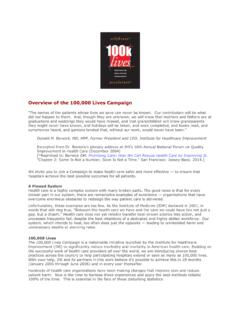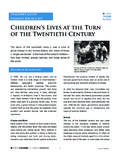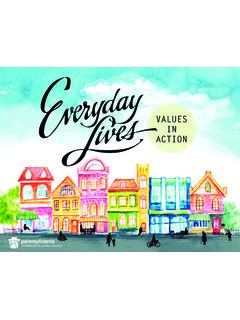Transcription of active lives children and young people survey
1 active lives children and young people survey academic year 2017/18. Published December 2018. 1. welcome contents Welcome to the first active lives children and young people survey report Levels of activity 3. summarising the activity levels of children and young people (aged 5-16) in England from September 2017 to July 2018. Types of activity 11. Given that attitudes towards sport and physical activity are often shaped by Volunteering 16. experiences in childhood, we have sought to explore and better understand not only Outcomes 23. the behaviours of children and young people , but also their attitudes towards sport Local level data 30. and physical activity, and the extent to which being active links to levels of mental wellbeing, individual development and social and community development. Attitudes 31. To maximise the value and usefulness of the findings, we have presented the overall Definitions 32. levels of activity both at and outside school, and summarised the picture of Demographic groups 33.
2 Engagement by key demographics, as well as the types of activity being undertaken. With a sample of over 130,000, we have been able to present data down to local Notes 34. authority level. This data can be accessed using the links embedded in each page to take you to the data tables which sit behind the headlines within this report. key information For the first release of active lives children and young people , we have taken the This report presents data from the decision to release the data in two parts. This first report focuses specifically on active lives children and young behaviours. The second report (to be published in March 2019) will focus on the people survey for the academic year attitudes of children and young people towards sport and physical activity, seeking to 2017/18. Data is presented for better understand the impact of confidence, motivation and perceived physical children and young people in school competence upon behaviours and activity levels.
3 Years 1-11 (ages 5-16) in England. Finally, I would like to take this opportunity to thank colleagues within the Department release dates for Digital, Culture, Media and Sport, the Department of Health and Social Care and the Department for Education who have been key partners in the development of this This release: 6 December 2018. survey , the network of County Sports Partnerships who have recruited the schools to Next release: 21 March 2019. take part and finally the schools, children , parents and teachers who took the time to complete the survey . find out more For further information on the data Lisa O'Keefe presented in this report, please visit the Insight Director active lives section of our website. 2. Creating a lifelong sporting habit 2. levels of activity definition This chapter presents information WHAT DO WE MEAN BY SPORT AND PHYSICAL ACTIVITY? on four levels of activity: active every day (at least 60 minutes every day). active across the week (an average of at least 60.)
4 Minutes a day, but not every day). Fairly active (an average of 30-59 minutes a day). Less active (less than an average of 30 minutes a day). 3. Creating a lifelong sporting habit levels of activity headlines Our data shows that of children and young people ( ) are meeting the current Chief Medical Officer guidelines of taking part in sport and physical activity for at least 60 minutes every day. A further ( ) sit just below this threshold, taking part on average for 60+ minutes a day across the week, whilst ( ) do less than an average of 30 minutes a day. less active fairly active active across active every day the week less than an an average of 30-59 an average of 60+ 60+ minutes average of 30 minutes a day minutes a day but not every day minutes a day every day of children ( ) are ( ) do an ( ) do 60. and young people fairly active but average of 60 minutes minutes or more ( ) do less than don't reach An or more a day but Every day An average of 30 average of 60 don't do 60 minutes minutes a day minutes a day every day 4.
5 Levels of activity school year group children and young people in Years 5-6 and 7-8 (top end of primary, lower end of secondary, ages 9-13) are more likely to be active every day, with young people in Years 9-11 (ages 13-16) the least likely to be active every day. Note: Data for Years 1-2. children for this question is collected by proxy from parents, while for Years 3-11, the pupils are asked directly. This may mean some of the differences observed between these year groups are partly methodological. 5. levels of activity gender Boys (20%) are more likely to be active every day than girls (14%). The gap between boys and girls who are active every day is wider from Years 5-6 (ages 9-11) upwards. active every day (60+ minutes). 6. levels of activity family affluence The family affluence scale provides an indication of the socio-economic profile of children and young people 's families. There is a clear gradient, with children and young people from the most affluent families generally being more active than those from the mid-affluent families, who in turn are generally more active than those from the least affluent families.
6 Note: See our definitions page for more details on family affluence. 7. levels of activity disability There is no real difference in the activity profile of children and young people with and without a disability, with only a small difference in less active ' for Years 7-8 (ages 11-13) and 9-11 (ages 13-16). Note: In order to make it understandable to them, children in Years 3-6 are asked a simpler question for disability. This means that Year groups 1-11 cannot be combined and may mean some of the differences observed between them are partly methodological. See the notes page for more detail. 8. levels of activity ethnicity Girls from Asian and black backgrounds and both boys and girls from other' backgrounds (such as Arab and South American), are more likely to be less active '. less active The age at which these differences are seen varies for each group: Girls from black backgrounds are more likely to be less active ' from Years 5-6. (ages 9-11) upwards Girls from Asian backgrounds are more likely to be less active ' in Years 9-11.
7 (ages 13-16) only (47% compared to 37% of all children and young people ). 9. levels of activity activity levels, every day, are higher at school compared to outside school Government guidelines set out that children and young people should get 30 minutes of their daily physical activity through the school day and 30 minutes outside of school. Our data shows that 28% of children and young people do 30 minutes or more every day at school, while 22% do so outside school. In contrast, children and young people are more likely to be doing less than an average of 30 minutes a day across the week ( be less active ) at school (60%) than outside school (47%). Activity levels differs by year groups, with children in Years 3-4 (ages 7-9) reporting similar rates of taking part every day at and outside school and children in Years 5-6 (ages 9-11) more likely to do so outside school. Both environments play a critical role in the overall activity levels of children and young people .
8 Activity levels 30+ minutes every day 10. types of activity participation our definition This chapter presents data Looking at participation at least once in the last week provides: broken down by activity An entry level view of participation overall group and looks at those who An understanding of which activities contribute to the make-up of have participated at least an active day. once in the last week. Data is also provided for swimming confidence and capability within this section. 11. types of activity active play and informal activity is the most common activity amongst children in years 1-2 (ages 5-7). A high number of children in Years 1-2 walk to get to school and other places, while over half have been swimming. ten most prevalent activity groups years 1-2 (ages 5-7). Note: Data for Years 1-2 for this question is collected from parents, while for Years 3- 11, the pupils are asked directly. This may mean some of the differences observed between these year groups are partly methodological.
9 Note: Individual activities are reported in the data table. 12. types of activity active play and informal activity remains the most common activity amongst children in years 3-6 (ages 7-11), closely followed by team sports Walking to get to school and other places and swimming are both less common than for Years 1-2 (ages 5-7) children with under a third taking part, while running begins to feature. ten most prevalent activity groups years 3-4 (ages 7-9) ten most prevalent activity groups years 5-6 (ages 9-11). Note: Individual activities are reported in the data table. 13. types of activity team sports is the most common activity amongst children and young people in Years 7-11 (ages 11-16). active play and informal activity remain common for secondary school children and young people , while swimming has dropped away, and is outside the top 10 by Years 9-11 (ages 13-16) with just 10% taking part. In Years 9-11, just over a quarter take part in gym or fitness activities.
10 Ten most prevalent activity groups years 7-8 (ages 11-13) ten most prevalent activity groups years 9-11 (ages 13-16). Note: Individual activities are reported in the data table. 14. swimming confidence and capability 77% of year 7 children can swim 25 metres unaided Guidelines indicate that children should be able to swim 25m unaided by the time they leave primary school. The data shows that 77% of Year 7 (first year of secondary school, age 11-12) children can do this. This only increases slightly to 81% by Year 11 (ages 15-16). In comparison, 86% of children of the same age (Year 7, ages 11-12) say they can tread water and 81% say they can self rescue. can swim 25m unaided Overall, 65% of all children and young people (Years 1-11, ages 5-16) can swim 25m unaided. There are some key inequalities within this: Boys (66%) are more likely to be able to swim 25m unaided than girls (63%). 86% of children and young people from the most affluent families can swim 25m unaided, compared to 42% of those from the least affluent families.











